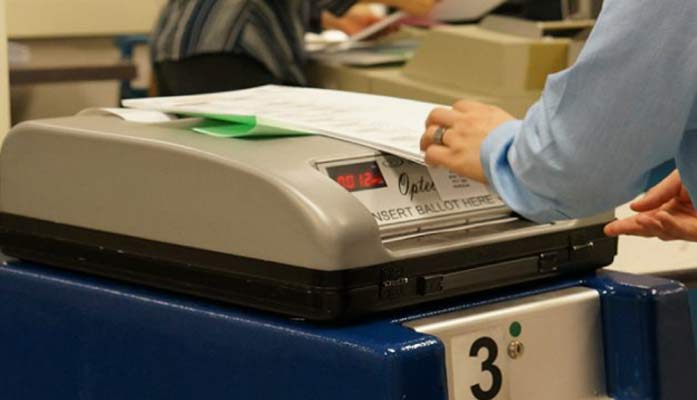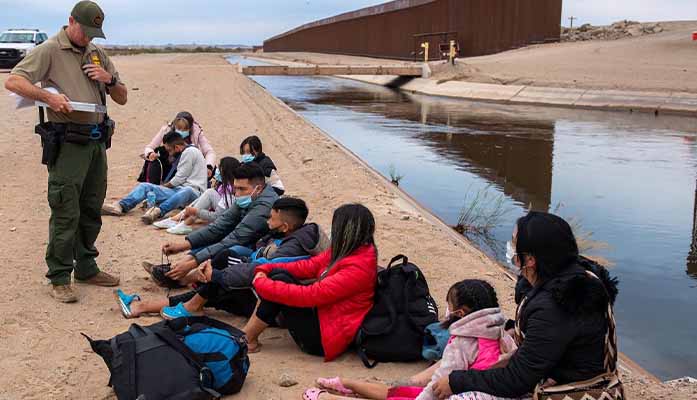
by Corinne Murdock | Feb 8, 2022 | Education, News
By Corinne Murdock |
Certain House Republicans have decided to shift from the defensive to the offensive concerning their opposition to school choice as proposed by the rest of their party.
Superintendent of Public Instruction candidate and State Representative Michelle Udall (R-Mesa) introduced HB2185, a bill to require annual standardized testing for Empowerment Scholarship Account (ESA) recipients from grades 3-12. It would also require schools to post an aggregate of the test scores on their website, organized by grade level. The bill would exempt students with disabilities. State Representatives Joel John (R-Buckeye) and Joanne Osborne (R-Goodyear) signed on as cosponsors.
The bill continues the three legislators’ arguments that ESAs needed greater oversight. Udall stated last October that she’s not opposed to school choice outright if it comes with “appropriate accountability measures.” Udall explained that charter schools initially had the same problems that plague certain schools receiving ESAs currently.
“The issue I have with ESAs is the lack of accountability. When I tried speaking to proponents about appropriate accountability, they walked away from the conversation (on multiple occasions),” tweeted Udall. “When we first started charter schools, we had the same problem. The lack of accountability led to subpar education for many. We had to add accountability over the years. Our students can’t afford to repeat that mistake again with private schools that have even less accountability. Children at subpar public schools (D/F letter grades) already have access to ESAs. And when I submitted a proposal with some modest accountability and a restriction that children eligible for the expansion could only use ESAs to attend high achieving schools, they walked away.”
Udall’s latest bill was assigned to the House Education Committee, but hasn’t been given a date for review.
Last December, there were talks that the Maricopa County Republican Party would censure Udall, John, and Osborne for voting against State Representative Shawnna Bolick’s (R-Phoenix) expansion of the ESA program as part of the summer budget bill. The party passed the resolution to oppose the three legislators in their campaigns — “In Support of Parental Involvement and Choice in Education,” introduced by former State Senate President Russell Pearce — with nine votes in favor, one against, and one abstention. The following is the text of Pearce’s resolution:
“Whereas Republicans, like most Americans, believe that parents, not bureaucrats, should be making decisions for their children’s education; Whereas it is a core conservative belief that the people who matter most in our schools are our students and our teachers, even though liberals believe it is the administrators, diversity training officers, and vaccine mandate supervisors; and
Whereas what remains of the old public school monopoly continues to fight to obstruct efforts to
expand school choice in Arizona, because they are desperate to hang on to as much money and control as they can for as long as possible; and Whereas today’s Democrat Party is targeting parents and has weaponized the Department of Justice to pursue parents who oppose radical curriculum like Critical Race Theory; and Whereas Arizona parents know what is best for their children and deserve as many education options as possible; now, therefore, be it Resolved, that the Maricopa County Republican Party remains 100% committed to expanding
school choice options for students and parents; and further be it Resolved, that the Maricopa County Republican Party encourages parents to rise up, run for school board offices, and make their voices heard, and that the Maricopa County Republican Party will support those efforts whenever possible; and further be it Resolved, that the Maricopa County Republican Party calls attention to, and opposes Republicans who campaign as conservatives while voting against school choice and against the best interests of students and parents – specifically Representatives Joanne Osborne, Michelle Udall, and Joel John.”
The party also opted to pass a resolution to hold Udall accountable for her voting record.
Udall aligns neatly with her party on other school-related issues: opposition to masking and vaccination mandates, and critical race theory, to name a few. On the topic of school choice, however, Udall disagrees, coming from the perspective of an educator and candidate for the state’s superintendent of education.
Udall has also supported efforts to make public schools more flexible for students’ unique needs.
Corinne Murdock is a reporter for AZ Free News. Follow her latest on Twitter, or email tips to corinne@azfreenews.com.

by Corinne Murdock | Feb 8, 2022 | News
By Corinne Murdock |
A total of seven out of election integrity bills considered by the Arizona Senate Government Committee on Monday were passed; due to time constraints, an additional six bills were held for later discussion. The committee passed the bills 4-3, every time along party lines, with the exception of State Senator Martín Quezada’s (D-Glendale) vote for SB1411.
Among those passed were SB1362, requiring every county recorder to tabulate early ballots at a polling place or voting center by 2024; SB1404, repealing the Active Early Voting List (AEVL) and limiting early ballot voting eligibility to those who expect to be absent from their precinct at the time of the election, are physically unable to go to the polls, are 65 or older, whose residence is over 15 miles from the polling place or precinct, can’t attend to polls on election day due to their religion, have a visual impairment, or qualifies as eligible via the Uniformed and Overseas Citizens Absentee Voting Act; SB1411, requiring counties with over 100,000 citizens provide an early ballot tracking system for their citizens by 2024; SB1357, prohibiting elections machines or devices that were certified by laboratories not accredited at time of certification; SB1358, requiring ballots from counties with voting centers to be separated and grouped by precinct; SB1457, requiring the Secretary of State (SOS) to ensure election machines meet standards such as no internet access, ability to sustain and track multiple users with unique credentials, and updated operating systems and software that match U.S. Department of Homeland Security standards; and SB1474, declaring primary and general election days as state holidays, prohibiting voting locations from being used as on-site early voting, and establishing voting on election day only.
For SB1357, State Senator Hatathlie said she couldn’t vote for the bill because nobody had answered whether or not the machines that were used during the last election were certified.
State Senator Kelly Townsend (R-Mesa) reminded the floor that there was testimony addressing Hatathlie’s concerns; she said that she also learned the EAC missed members so that they couldn’t vote.
“I’m not sure if that’s why they let the accreditation lapse for some of these groups, but at the time that they certified these machines they did not have a valid accreditation. Therefore it’s in question whether or not they certified [the machines] legally,” said Townsend.
The Arizona Association of Counties (AACo) spoke out against several bills, including: SB1358, SB1457, and SB1474.
AACo Executive Director Jennifer Marson argued that SB1358’s requirement to separate ballots by precinct would take counties backwards. Townsend rebutted that vote centers made it more difficult to weed out “bad actors” stuffing ballots and overvoting, versus tabulations that take place at the precinct level. Marson then argued that centers have the ability to access precinct totals and other pertinent organizational information through election management software. Townsend responded that compiling all the ballots together without separation for precinct would make review of them difficult if not impossible after initial counting, especially for audits. She used the example of her time at the retail clothing chain, Miller’s Outpost, prior to electronic filing, meaning she relied on an expansive paper filing system to check customers’ credit card information. Similar to ballots, Townsend argued, the necessity of breaking down all of that stored information into categories and subcategories made it easier to locate and review.
As for SB1457, AACo Senior Legislative Associate Megan Kintner informed the committee that their equipment wouldn’t allow for their operations to create individualized codes for every single poll worker. She added that the bill’s requirement for additional observers would be difficult to satisfy because they already had a hard time securing volunteers. Kittner also noted that the bill didn’t address what counties should do when volunteers don’t show up. Townsend responded that Kittner’s colleague, Marson, told her that the unique log-ins were possible to do, with the exception of volunteers checking people in for poll books, and suggested that Kittner check back in with Marson on that information. Majority Whip Sonny Borrelli (R-Lake Havasu City) ignored Kintner’s concerns of logistics, emphasizing the greater need for accountability. Borrelli also challenged the general notion that no backdoor access was possible with election machines.
“Nothing is ‘not hackable,’ so let’s put as much prevention in it as possible. I’ve said this before: keep locks on your doors, keep honest people honest,” insisted Borrelli. “The intent is, whoever’s going to log into the system, we need to know who they are,”
SB1457 may receive some additional language; Borrelli was open to a suggestion from Townsend on adding an accountability aspect for video streams that get interrupted, such as a requirement to stop counting. Borrelli noted that even the legislature has to pause its operations when their streaming system goes down.
Townsend said that the bill would ward off bad actors relying on ease of access through community log-ins. She referenced the Miller’s Outpost operations again, noting that they had unique log-ins for their employees.
Marson said that voting machines have existed in America since 1881, and that states back then could select their own election day. The referenced voting machine relied on push button and interlock mechanics to select only single candidates per race and then reset for a new vote after the voter left the booth. When Townsend asked how long it took precincts to count votes when they counted by hand only, Marson said she didn’t know and couldn’t find the answer. However, Marson said that records reflected that states had several months to file their results, meaning they didn’t have a rush to complete their work in a day.
“I think this just underscores the idea that we should do a lot of research to see what can be restored, and what makes sense and what doesn’t,” said Townsend.
Although the committee denied Quezada’s amendment to SB1474 removing language about prohibiting voting locations from being used as on-site early voting, Townsend revealed that some within the Republican caucus oppose the bill, meaning she’ll have to make inroads with
“I still think that precinct voting on the day of and having a holiday is better, but we have to get it on the governor’s desk,” said Townsend.
Marson spoke up again to question how the elections would be conducted if public bodies were ordered to be closed, and asked when elections officials running the elections would have time to vote. Her questions weren’t addressed. Committee Democrats insisted that there wasn’t evidence of widespread fraud that necessitated this bill.
Due to time constraints, Townsend held the other bills for review another day: SB1058, prohibiting drive-up voting and voting through a drop box outside of a polling place, voting center, or the offices of either the county recorder or elections department; SB1343, requiring all early, provisional, and conditional provisional ballots to be separated, tabulated, and recorded by their precinct and category; SB1359, requiring all elections workers to have a unique password for accessing any election system, which would be changed every two weeks; SB1360, expanding rights for election observers such as documenting their observations, appealing an ejection from the election location, and asking questions of election officials; SB1380, requiring county recorders to use USPS National Change of Address (NCOA) information to weed out voters whose address changed; and SB1477, requiring the Secretary of State (SOS) to notify county recorders of relevant felony convictions every month.
Corinne Murdock is a reporter for AZ Free News. Follow her latest on Twitter, or email tips to corinne@azfreenews.com.

by Terri Jo Neff | Feb 7, 2022 | News
By Terri Jo Neff |
The State of Arizona is getting no support from the White House against an ongoing invasion by Mexican cartels, which gives Gov. Doug Ducey the authority to deploy the Arizona National Guard in self-defense, according to a legal opinion released by Arizona Attorney Mark Brnovich on Monday.
“The federal government’s failure to secure the border and protect Arizona from invasion is dangerous and unprecedented,” the 25-page opinion states. “Thankfully, the Founders foresaw that States might need to protect themselves from invasion and made clear in the Constitution that States retain the sovereign power to defend themselves within their own territory.”
The attorney general’s opinion was prompted by an inquiry submitted in October by Rep. Jake Hoffman (R-LD12) about whether the Biden Administration “has failed –intentionally or unintentionally– to uphold its obligations” under Article IV of the U.S. Constitution to protect Arizona from invasion.
The opinion contends the federal government “has lost or severely degraded its operational control” of Arizona’s 372-mile border with Mexico, where cartels and gangs are openly trafficking in drugs, weapons, and human beings while engaging in attacks on Arizonans and acting “as if they are above the law.”
Among the issues the attorney general examined in response to Hoffman’s inquiry was the definitions of “actually invaded” and “invasion” as used in the State Self-Defense Clause and the Invasion Clause of the U.S. Constitution.
ARTICLE I, SECTION 10
“…No State shall, without the Consent of Congress, lay any Duty of Tonnage, keep Troops, or Ships of War in time of Peace, enter into any Agreement or Compact with another State, or with a foreign Power, or engage in War, unless actually invaded, or in such imminent Danger as will not admit of delay.”
ARTICLE IV, SECTION 4
“The United States shall guarantee to every State in this Union a Republican Form of Government, and shall protect each of them against Invasion; and on Application of the Legislature, or of the Executive (when the Legislature cannot be convened) against domestic Violence.”
The examination also included whether a state has constitutional power to defend itself from “hostile non-state actors” such as armed cartels or only an invasion by a foreign power. Finally, the attorney general had to determine whether the current crisis at the Arizona / Mexico border satisfies the definitions of “actually invaded” and “invasion.”
“The violence and lawlessness at the border caused by transnational cartels and gangs satisfies the definition of an ‘invasion’ under the U.S. Constitution, and Arizona therefore has the power to defend itself from this invasion under the Governor’s authority as Commander-in-Chief,” the opinion states, adding that an invasion “permits the State to engage in defensive actions within its own territory.”
The legal questions addressed by the attorney general have not been adjudicated in court with factors similar to the situation in Arizona. However, the opinion was welcomed by Hoffman, who called on Ducey to utilize the powers afforded to him by the U.S. Constitution to immediately secure the border.
“I’m glad to see that Attorney General Brnovich today agreed with my assessment that the crisis occurring on our southern border constitutes an invasion and a total failure by the Biden administration to fulfill its constitutional obligation to protect the people of Arizona,” Hoffman said.“The human smuggling, cartel drugs and violence, sex trafficking, and other illicit activity must end.”
Ducey’s office did not issue a formal comment on whether the governor agrees with the opinion’s legal conclusions of his authority as commander-in-chief. Since April 2021, several dozen National Guard soldiers have been rotated in and out of border county sheriff’s offices to perform administrative, non-law enforcement functions.
This has been well-received by the sheriffs as it frees up deputies to respond to the increase in reported crimes along the border.

by Terri Jo Neff | Feb 7, 2022 | News
By Terri Jo Neff |
With telehealth services growing in popularity and necessity during the pandemic, U.S. Rep. David Schweikert (R-AZ) has signed a letter with several members of Congress calling on House and Senate leadership to include an extension of Medicare pandemic telehealth authorities in upcoming government funding legislation.
The letter acknowledges that telehealth—or telemedicine as it is also called—has become an essential part of the health care system, especially in rural communities. Congress recognized the importance of such services when it passed COVID-19 legislation to increase access to telehealth services for Medicare beneficiaries.
Telehealth services allows a physician or a specialist to provide healthcare without an in-person office visit. It also allows remote monitoring of a patient’s vital signs or other information, and provides for secure messaging or email with medical personnel.
But expanded access and funding for Medicare beneficiaries to utilize the services is temporary as it is tied to the COVID-19 public health emergency declaration, which is renewed in three-month increments.
According to the Jan. 28 letter, extending the current coverage of Medicare telehealth services would provide much-needed certainty to health care providers and patients. It would also give Congress time to enact permanent telehealth legislation to keep up with the burgeoning industry.
“Ramping up telehealth requires significant costs and resources from health care providers,” the letter to Majority Leader Chuck Schumer, Senate Minority Leader Mitch McConnell, House Speaker Nancy Pelosi, and Minority Leader Kevin McCarthy states. “Without more definitive knowledge about the duration of the pandemic and Medicare’s long-term coverage of telehealth, many organizations have been hesitant to fully invest in telehealth.”
Permanent legislative reforms to telehealth services are included in various current bills under consideration, including the CONNECT for Health Act which has bipartisan support from over 170 members of Congress. Such long-term solutions are imperative to increase access to care, reduce costs, and improve health outcomes, the letter states.
“An extension of the telehealth authorities would provide assurance that the investments will be sustainable over the long term. It would also reassure patients that their care will not end abruptly,” it states.
Nearly four dozen lawmakers signed the letter supporting a telehealth pandemic extension. The signers run the gamut of political ideology, including Schweikert and fellow Representatives Bill Johnson (R-OH), Cheri Bustos (D-IL.), and Don Bacon (R-NE).
Signers from the U.S. Senate include Lisa Murkowski (R-AK), Lindsey Graham (R-SC), Bernie Sanders (I-VT), Amy Klobuchar (D-MN), and Marco Rubio (R-FL). Both of Arizona’s Senators also signed.

by Terri Jo Neff | Feb 6, 2022 | News
By Terri Jo Neff |
A federal judge has been asked to award damages to the chairwoman of the Arizona Republican Party and her husband for fighting a Congressional subpoena which seeks detailed data from four phone numbers assigned to the couple’s T-Mobile business account, including records of calls to and from their medical patients.
Last week Kelli and Michael Ward filed a federal lawsuit in an attempt to block a subpoena issued by the U.S. House Select Committee investigating the Jan. 6, 2021 attack in Washington DC. The subpoena demands T-Mobile turn over records for the period of Nov. 1, 2020 to Jan. 31, 2021 from an account in the name of Mole Medical Services P.C., a company owned by the Wards.
The Feb. 1 lawsuit filed in U.S. District Court seeks a court order declaring the Committee’s actions in issuing the subpoena violated federal law and Arizona law. It also seeks an order quashing the subpoena and enjoining T-Mobile from releasing any data to the Committee.
According to the Feb. 1 lawsuit, T-Mobile’s Legal and Emergency Response Team sent an advisory to Mole Medical Services after receiving the Jan. 19 subpoena. T-Mobile intended to comply with the subpoena on Feb. 4 unless provided proof by Feb. 2 of the filing of a motion for protective order, motion to quash, or other legal process “seeking to block compliance.”
The Committee has not commented on what drew their attention to the Wards or to their phone records, but the subpoena demands detailed records of incoming and outgoing calls—including call duration and associated phone numbers—as well as metadata, or call data records.
The lawsuit and motion to quash argues that U.S. Supreme Court precedent places the burden on the House Select Committee to justify the need for the information being sought. Instead, the subpoena is so broadly written that it substantially infringes on “the right to privacy” guaranteed under Arizona state law, the lawsuit argues.
The Wards were among the 11 Republicans whose names were listed on the 2020 General Election ballot as Arizona’s electors for then-President Donald Trump. Both also signed an “alternate” slate of Arizona electors which they hoped could be used on Jan. 6, 2021 instead of the 11 electors for now-President Joe Biden.
The lawsuit concedes Kelli and Michael Ward use their business account phones for personal calls, including political communications, but argues that the data which would be disclosed by T-Mobile does not relate to a sufficiently important government interest between the Wards and the Jan. 6 attack at the Capitol.
In addition, two of the four phone numbers associated with the targeted T-Mobile account are used by the couple’s children, according to the lawsuit. “Congressional investigators cannot possibly have any legitimate investigative interest in invading the personal privacy rights of the Wards’ children,” the filings state.
Several arguments against the subpoena center on the Wards’ work as medical professionals which is provided state and federal privileges of medical privacy and physician-client communications. The Committee has not addressed how it would limit the use or disclosure of confidential patient information that might be revealed if T-Mobile releases the demanded data, the lawsuit argues.
Kelli Ward is a practicing Doctor of Osteopathic Medicine who practices medicine exclusively in the field of medical weight loss. She uses a Health Insurance Portability and Accountability Act (HIPAA)-compliant videoconferencing system for telemedicine visits with her patients, although there are times she relies on her Mole Medical phone to speak with patients, the lawsuit states.
Michael Ward is also a practicing Doctor of Osteopathic Medicine who serves as medical director for an air ambulance company. He actively practices emergency medicine in Arizona, mostly in the Lake Havasu City area where the couple live in Mohave County.
“In certain circumstances, Michael Ward gives the Phone Number to patients to follow up on their questions, the status of their condition, and the state of the improvement of their health,” the lawsuit states, adding that the same number serves as a point of contact for Ward’s work for the air ambulance, which involves calls from emergency medical technicians and paramedics about patients.
The lawsuit which also names Rep. Bennie Thompson (D-Mississippi) in his official capacity as the Committee’s chairman calls into question whether the subpoena was properly issued by the Committee due to quorum issues as well as a House rule which requires the Committee’s members to “authorize” a subpoena.
The case has been assigned to U.S. Magistrate Judge James F. Metcalf. Each defendant will have 15 days to file a response once served with the Wards’ complaint and summons.

by Terri Jo Neff | Feb 6, 2022 | Economy, News
By Terri Jo Neff |
QR codes can be scanned to download a coupon, sign in at a medical appointment, even look at a restaurant’s menu while waiting to be seated. They can also used by cybercriminals to scam people, the FBI is warning.
A QR code is a square barcode that a smartphone camera can scan and read to provide quick access to a website. It can also be used to prompt the user to download an app or process a direct payment to an intended recipient. And businesses large and small utilize QR codes for customer rewards programs.
The popularity of QR codes grew during the COVID-19 pandemic in part due to the contactless nature of the technology. But more and more cybercriminals are now tampering with the codes to surreptitiously redirect victims to a malicious site in order to steal login and financial information, the FBI warns.
“Cybercriminals tamper with both digital and physical QR codes to replace legitimate codes with malicious codes,” the FBI stated. “A victim scans what they think to be a legitimate code but the tampered code directs victims to a malicious site, which prompts them to enter login and financial information. Access to this victim information gives the cybercriminal the ability to potentially steal funds through victim accounts.”
The scammers can also utilize a QR code to embed malware which allows a cybercriminal to gain remote access to a victim’s device, and even redirect money transfers to the criminal, according to the FBI. The cybercriminal can even leverage financial information stolen from the device to withdraw funds from the victim’s bank accounts or credit / debit cards stored on the device.
“Law enforcement cannot guarantee the recovery of lost funds after transfer,” the FBI stated.
Companies are advised to consider whether the immediate convenience of offering QR code options is worth the potential cost of dealing with security breaches and disgruntled customers.
And for those consumers who really want to utilize QR codes, the FBI has some suggestions to reduce -albeit not eliminate- the risk of falling victim to a scammer.
According to the FBI:
- Do not download a QR code scanner app, as this increases your risk of introducing malware onto your device. Instead, use the built-in code scanner incorporated in your camera app.
- Avoid making payments through a site you were sent to via a QR code. Instead, manually enter a known and trusted URL to complete the payment.
- Also, use caution when asked to enter any login, personal, or financial information from a site you navigated to from a QR code.
- If you receive a QR code that appears to be from someone you know—such as a local business or medical provider—contact them through a known number or address to verify they sent you the code.
- Do not download an app to your device via a QR code. Use your device’s app store instead for any download.
- If scanning a physical QR code, ensure the code has not been altered or tampered with, such as a sticker placed on top of the original code.
- Once you scan a QR code, check the URL it opened to make sure it is the intended site and looks authentic. A malicious domain name may be similar to the intended URL but with typos or a misplaced letter.
- Finally, if you receive a notice of a failed payment from a company you recently made a purchase with and the only option you are given for completing the payment is via a QE code, call the company to verify. But do not use the phone number included on the notice—ensure you obtain the number through a trusted site.
If you believe you have been the victim of a QR code scam, contact your local police department or sheriff’s office. They may conduct the investigation or refer the matter to the nearest FBI office.
Meanwhile, suspicious QR code activities can reported directly to the FBI Internet Crime Complaint Center at www.ic3.gov






